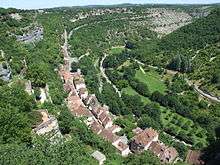Side valley
A side valley and a tributary valley are valleys whose brook or river flows into a greater one.
Upstream, the valleys can be classified in an increasing order which is equivalent to the usual orographic order: the tributaries are ordered from those nearest to the source of the river to those nearest to the mouth of the river. A confluence is where two or more tributaries or rivers flow together.
Orographic order (e.g. Humber)
In the orographic classification (order of rivers) the tributary river has order n+1, if n describes the primary (or main) river. A river which flows directly into the ocean (e.g. the English rivers Thames or Humber) has the orographic order n=1, the River Ouse n=2, the Wharfe n=3 and so on.
Basic facts of geomorphology
However, the term "side valley" is used rather for higher order valleys near the mountains (example above: the Pennines), for the lower valleys often do not show a drastic relief. The reason is a simple one: The "mainstem river" (into which the secondary river flows) passes much more water than its tributaries and therefore
- has a lower current (see Hydrology)
- much more fine sediments
- which are deposed in a more flat matter.
The higher the order of a valley, the steeper usually are the hillsides resp. valley slopes. Looking upstream, the steepest slopes are normally near the source of a brook (with the exception of very hard rocks in downstream direction).
Hanging valleys
The estuary of broad rivers lies rather in flat regions (river flats) than of rivers in higher elevation. Therefore, the height difference of the tributary near its mouth is small (e.g. 1 m per km)—but much more at waters of higher order (in the Alps up to 100 m per km). This is one reason of the large number of hanging valleys in some mountain ranges (e.g. Salzburg or Graubünden).
The others are glaciologic or geologic reasons:
- The huge glaciers of the ice age caused a violent erosion which resulted in many U-shaped "glacial valleys", especially in altitudes of 400–800 m which is typical for alpine main valleys.
- At the place where the tributary flew into the river before the glacial period, there is now a valley shoulder (see figure). The side valley has to lose a lot of its height and is developing into a hanging valley.
All these stages of valley genesis can be seen in higher mountain ranges - e.g. in the "young" Rocky Mountains, in the "old" ranges and fjords of Scandinavia, or in the Eastern Alps (Salzach or Inn valley). Just in the Glens of Scotland the type 2 is predominant.
Shape of side valleys

Whereas the valleys near the river flats don't have special forms, the shape of alpine valleys depends much more from the former glaciology and of the rock type.
Like the main valleys described above, the side- or secondary valley can be V-shaped or U-shaped. Also the valley floor varies - from just a few meters up to some 100 m (e.g. Bad Gastein or St. Moritz, where small towns have been developed instead of 1000 or 1500 m altitude.
Some valleys are stepped in longitudinal direction (German "Talstufe") which means that these zones show a quicker current than in average. Therefore, the brook will dig its own narrow canal, and the eroded sediments are deposed at the end of each clammy, forming a series of local plains. They are an important basis of traditional mountain farming because of excellent places for alpine agriculture or pastures.
Miscellaneous
Orography: The descriptive terms right or left side-valley (resp. tributary) always apply from the perspective of looking downstream (in the direction the current is going).
Sandbanks: often at reaches with slow current, especially near the river banks. Looking at the various rock types of the gravel is an excellent and cheap survey for a summarized geology of the rivers watershed (catchment area).
Valley forks: at most confluences it is clear which stream is the main river and which is the tributary - as one stream is both much longer and carrying clearly more water than the other. It can, however, happen that one stream is longer, but the other carries more water. This case has no fixed rules to decide. Usually the longer valley is chosen as the main valley, e.g. for the higher number of villages.
But in Lowlands the decision may be arbitrary: In Switzerland the long Alpine Rhine is chosen as the main stream, although the Aar carries more water for her huge midland area.
In the case of the Mississippi River (which carries more water) and Missouri River (which is much longer) the choice is made according to the opposite criterion.